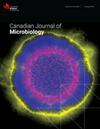Survival of antimicrobial resistant Salmonella Heidelberg inoculated into microcosms of fresh pine wood shavings for broiler litter.
IF 1.6
4区 生物学
Q4 BIOTECHNOLOGY & APPLIED MICROBIOLOGY
Canadian journal of microbiology
Pub Date : 2025-01-01
Epub Date: 2024-10-22
DOI:10.1139/cjm-2024-0088
引用次数: 0
Abstract
Highlights: S. Heidelberg survived up to 21 days in PWS which is often used as broiler bedding. S. Heidelberg abundance and survival was correlated with the water activity of PWS. S. Heidelberg strains that carried higher copy numbers of small Col plasmids were the dominant strains isolated from PWS at later time points. S. Heidelberg strains harboring transmissible plasmid carrying AmpC-like beta-lactamase gene persisted longer in PWS without antibiotic pressures for AMR.
接种到肉鸡粪便新鲜松木刨花微生态系统中的耐抗菌素海德堡沙门氏菌的存活率
本研究对接种到新鲜松木刨花(PWS)微生态系统中的三株海德堡肠炎沙门氏菌(S. Heidelberg)不同抗菌素耐药性(AMR)特征的鸡尾酒菌株进行了基因组特征分析。这些菌株分别从肉鸡的粪便(SH-AAFC)、胴体(SH-ARS)和大腿(SH-FSIS)中分离出来。SH-AAFC在一个IncI1质粒上携带一个抗菌基因(ARG)blaCMY-2,而SH-FSIS在一个IncC质粒上携带多个ARG(floR、cmlA1、tet(A)、blaTEM-1B、ant(2'')-Ia、ahph(6)-Id、ahph(3'')-Ib和sul2)。SH-ARS 具有泛敏感性。沙门氏菌在第 0、1、7、14 和 21 天死亡。对 77 个分离菌株进行了抗生素药敏试验和全基因组测序。接种后 21 天,沙门氏菌的数量减少了 4.4 Log10 CFU/g,PWS 的水活性与沙门氏菌的存活率相关。与 SH-FSIS和SH-ARS相比,SH-AAFC克隆种群在PWS中存活的时间更长。与它们的祖先相比,SH-AAFC克隆种群的Col质粒拷贝数更高,而一些SH-ARS克隆种群则从SH-FSIS种群中获得了溶菌性噬菌体。这些结果表明,质粒(可能携带ARGs)和噬菌体等移动遗传决定因素在海德堡氏菌在用作肉鸡窝料的PWS中的持续存在中发挥了作用。
本文章由计算机程序翻译,如有差异,请以英文原文为准。
求助全文
约1分钟内获得全文
求助全文
来源期刊
CiteScore
4.80
自引率
0.00%
发文量
71
审稿时长
2.5 months
期刊介绍:
Published since 1954, the Canadian Journal of Microbiology is a monthly journal that contains new research in the field of microbiology, including applied microbiology and biotechnology; microbial structure and function; fungi and other eucaryotic protists; infection and immunity; microbial ecology; physiology, metabolism and enzymology; and virology, genetics, and molecular biology. It also publishes review articles and notes on an occasional basis, contributed by recognized scientists worldwide.

 求助内容:
求助内容: 应助结果提醒方式:
应助结果提醒方式:


